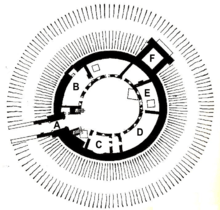Shell keep

A shell keep is a style of medieval fortification, best described as a stone structure circling the top of a motte.
In English castle morphology, shell keeps are perceived as the successors to motte-and-bailey castles, with the wooden fence around the top of the motte replaced by a stone wall. Castle engineers during the Norman period did not trust the motte to support the enormous weight of a stone keep. A common solution was to replace the palisade with a stone wall then build wooden buildings backing onto the inside of the wall. This construction was lighter than a keep and prevented the walls from being undermined, meaning they could be thinner and lighter.
Examples include the Round Tower at Windsor Castle and Clifford's Tower at York Castle,[1][2][3] and the majority were built in the 11th and 12th centuries.[4]
- The shell keep of Windsor Castle was built by Henry II and remodelled in the 19th century.
 York Castle's Clifford Tower: A shell keep on a motte
York Castle's Clifford Tower: A shell keep on a motte A cross-section of York Castle's shell keep and motte, produced in 1903 by Sir Basil Mott; "A" marks the 20th century concrete underpinnings of the motte; the low walls enclosing the base of the motte are a 19th-century addition.
A cross-section of York Castle's shell keep and motte, produced in 1903 by Sir Basil Mott; "A" marks the 20th century concrete underpinnings of the motte; the low walls enclosing the base of the motte are a 19th-century addition.- Restormel Castle built around the motte
 Plan of Restormel Castle
Plan of Restormel Castle
Notes
- ↑ Pettifer 2002, p. 7.
- ↑ Darvill, Stamper & Timby 2002, p. 196.
- ↑ Hull 2006, p. 99.
- ↑ Hislop 2013, p. 96.
References
- Brown, Reginald Allen (1989). Castles from the air:Cambridge air surveys (illustrated ed.). CUP Archive. p. 52. ISBN 0-521-32932-9.
- Darvill, Timothy; Stamper, Paul; Timby, Jane (2002). England: an Oxford archaeological guide to sites from earliest times to AD 1600 (illustrated ed.). Oxford University Press. p. 196. ISBN 0-19-284101-7.
- Hislop, Malcolm (2013). How to read castles. London: Bloomsbury Academic. ISBN 9781472521613.
- Hull, Lise (2006). Britain's medieval castles (illustrated ed.). Greenwood Publishing Group. p. 99. ISBN 0-275-98414-1.
- Pettifer, Adrian (2002). English Castles: A Guide by Counties (illustrated ed.). Boydell & Brewer. p. 7. ISBN 0-85115-782-3.